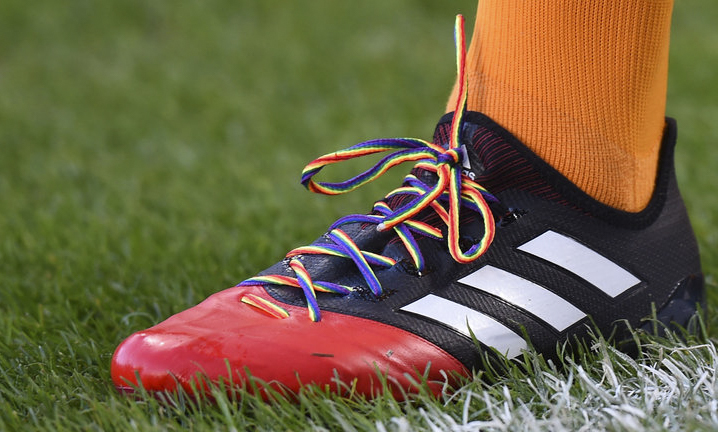
c/o skysports.com
It is official: Football’s fight against homophobia might have reached a tipping point.
About 10 days ago (Nov. 14), The Football Association (FA) in England announced that all 72 member clubs of the English Football League (EFL), including the Premier League, would unite in their support of LGBTQ inclusivity by turning pitchside equipment rainbow colored. This not only marks the second year for the EFL’s involvement in the Rainbow Laces campaign, but also forms part of a new, three-year partnership with Stonewall, the largest LGBTQ-rights organization in Europe.
The initiative reveals The FA’s strengthened determination in making the Beautiful Game more and truly inclusive toward LGBTQ-identifying players, staffs, and fans alike. As a head-on approach to anti-LGBTQ discrimination, the partnership is a huge deal for soccer, which has waited years to declare for a long-term, consistent support for the LGBTQ community.
If you are still puzzled, chew on the following: How many top athletes worldwide are openly gay? And how were their coming outs received? It’s unfortunate that the issue of homosexuality in soccer is still taboo among both players and fans.
Historically speaking, football, or sports in general, has left little or no room for narratives outside of the established “norm” characterized by cold, pragmatic virility. During the second half of the 19th century, sport became an independent practice separated from other social activities. Since contact with other bodies is functional and sexuality is set aside, engaging in sports has since implied the desexualization of the human body, the neutralization of its erotic power, and eventually, the normalization of heterosexuality. In what is often referred to as “the most popular sport,” this was furthered following the tactical revolution of assigning players with more specific functional roles and less freedom.
The community’s mainstream attitude towards its LGBTQ members remains harsh and intolerant, which breeds and is in turn reinforced by the toxic fan culture dominated by heterosexuality. That is, on the sideline, homophobic slurs like are repeated ad infinitum. And homophobia is perpetuated through everyday behavior in less official channels.
Such culture of homophobia has cost too much for the football community despite the positive work that has been done. While there has been a great deal of talk and a large number of initiatives aimed against homophobia in football, real change remains elusive, even after the death of Justin Fashanu. Fashanu was one seen as one of English football’s great hopes. But his career and life have been disturbed greatly after coming out in 1990. He quickly became a scapegoat for fans and fellow professionals, and at Nottingham Forest, even the beloved Brit Brian Clough didn’t give him enough shielding from fan insults. Eventually, after being obliged to switch clubs several times, Fashanu tragically committed suicide.
Still, with increasing worldwide attention, many efforts have been made, at least in the EFL community, to fight against anti-LGBTQ discrimination. Wembley Arch was lit up in rainbow colors for last year’s campaign and again this year for a groundbreaking fixture at Wembley Stadium featuring Britain’s most successful LGBTQ football club, Stonewall FC. Elsewhere last year, FIFA even introduced a new anti-discrimination monitoring system for the 2018 World Cup qualifiers and the FIFA Confederations Cup in an attempt to clamp down on discrimination. It was a relief to see that all 64 World Cup games in Russia were monitored by the three anti-discrimination match observers in the stands.
That is, soccer’s attitudes to sexuality are coming under increasing scrutiny from inside and outside the game. According to a BBC Radio 5 live survey in late 2016, 82 percent of supporters say they would have no issue with a gay player, while 8 percent of fans still claim they would stop supporting their team if one of their players came out. And that is within their rights, but thanks to the work of Stonewall, the FA, and many LGBTQ fan groups, homophobic abuse no longer is. The baton is now passed to everyone in the soccer community to prevent the abuse and violence from that eight percent, and the answer is simply: “If you hear something, say something.” This will come as a shock to those who decide to remain on the opposite side because they have yet to figure out we are on the same team.
Henry Yang can be reached at hyang01@wesleyan.edu.